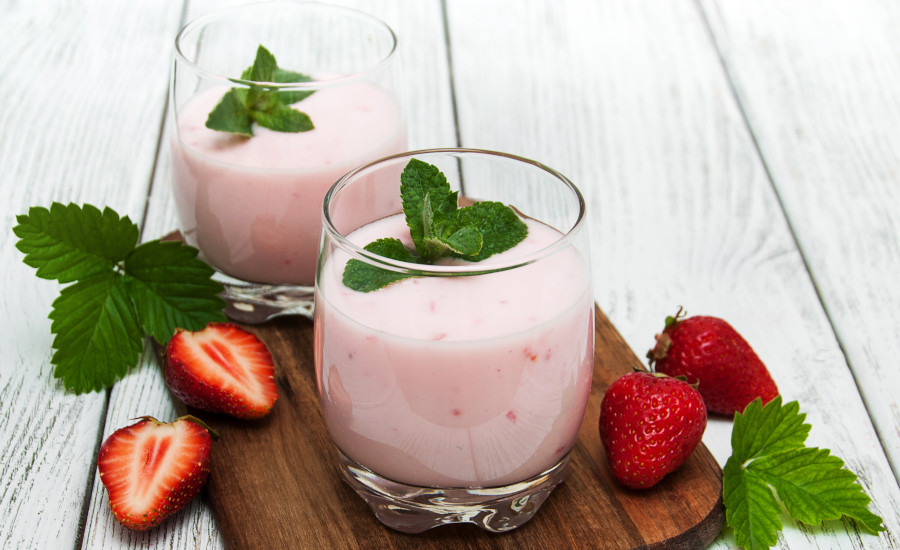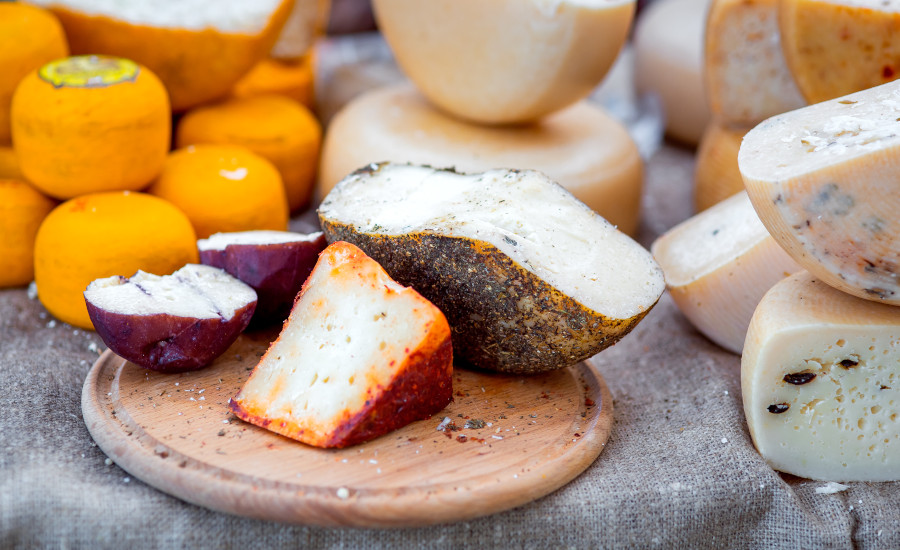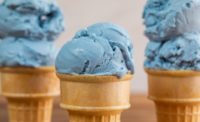The development and inclusion of novel ingredients in dairy products are adding spice to a typically conventional category. By combining new taste and functional elements in selections, processors are in position to transform traditional offerings into more appealing options while standing out in a crowded market, analysts say.
“A differentiator could be flavor intensity and/or unique flavors or flavor pairings,” says Jacob Fay, applications lab technologist for Prova Inc., a Beverly, Mass.-based provider of extracts and flavors. “There are many products that you can taste with your eyes closed and think they are unflavored, but are being called vanilla, chocolate, and more. If one can achieve an authentic flavor profile that truly tastes like its namesake, that will really take it to the next level.”
Processors that create a “signature” taste profile, meanwhile, also could stand apart, Fay notes. That may include, for instance, adding or blending in different species of vanilla extracts such as planifolia or tahitensis, or taking chocolates “up a notch” with smoke, or spice notes such as cinnamon, he states.

Producers of premium dairy products already are seeking to pair vanilla with other natural compounds such as strawberry, chocolate, or coffee to potentiate the overall flavor profile, says Branin Lane, global vice president of innovation, quality and compliance for Nielsen-Massey Vanillas Inc., a Waukegan, Ill.-based provider of vanilla extracts and natural food flavors. He notes that emerging flavors such as lavender, cardamom, and rose could all be areas of innovation for dairy producers, but consumer taste demands tend to differ by region and seasonality. Almond and coffee extracts, for instance, are extremely popular in the fall and winter, while shoppers favor citrus flavors in the spring.
The diverse types of vanilla with distinct flavor profiles also can make it easier for processors to expand their array of product varieties.
“When added to other sweet flavors such as caramel, butterscotch, or even fruits, pure vanilla can give more depth and complexity in way that consumers may not experience with a single ingredient on its own,” Lane notes.
Indeed, flavor blends could help create excitement around “tried-and-true” flavors such as vanilla, says Smaro Kokkinidou, principal food scientist for Cargill, a Minneapolis-based ingredient provider. “Pair vanilla with chia or matcha for an ethnic flair; opt for a kid-friendly mashup like vanilla-marshmallow; or delight consumers with a summer-infused fruit combo such as vanilla and strawberry cream,” she states.
Wellness elements can pack a wallop
The diverse types of vanilla with distinct flavor profiles also can make it easier for processors to expand their array of product varieties.
Dairy processors that leverage ingredients that are attractive to the large segment of health-conscious shoppers also will be in better position to boost product awareness and activity, analysts say.
Ingredients with inherent therapeutic properties are most influential as physical and mental health become the dominant driver behind new dairy products, says Philip Caputo, marketing and consumer insights manager for Virginia Dare, a New York-based flavor supplier. That includes adaptogens, botanicals and functional fruits for emotional wellbeing, he states, noting that calming and relaxing flavors include passionfruit, chamomile, blackberry lavender, blackcurrant mint and white tea nectarine with honey.
Flavors for physical support include elderberry acai or tart cherry boysenberry for immunization; golden chai turmeric or blueberry matcha for anti-inflammation; and apricot mango or bilberry goji for vision, Caputo says.

Also gaining in popularity are flavors with a link to fermentation, says Sudarshan Nadathur, chief flavorist, dairy, and protein, for Chicago-based ingredient supplier ADM. He notes that processors could capitalize on the connection consumers are making between fermentation and gut health.
Such flavors include ginger, black limes, and preserved lemons, Nadathur states, adding that “yogurts and fermented milks already have a consumer-perceived health halo, and incorporating trending flavors associated with fermentation into these offerings [is] further enticing shopper purchase.”
Indeed, growing interest in fermented products is leading to the development of more ethnic flavors for dairy and plant-based dairy-alternative products, Kokkinidou says.
“Flavors like tres leches, matcha, and chai — and even exotic fruit flavors like tamarind, guava, tamarillo, and pomelo — are all gaining a foothold because they enhance creaminess or pair well with the sour, tangy notes often associated with fermented offerings,” she states.
Citrus flavors, meanwhile, are becoming more popular in yogurts, shakes and frozen treats as additional shoppers associate the elements with support for immune functions, Nadathur notes. Flavors include such traditional selections as orange, lime, and lemon, along with regional varieties, including calamansi, cara cara orange, and yuzu, he states.
“Bright citrus can also be perceived as invigorating and refreshing, which may spark a mood boost, which is a desired target of many consumers,” Nadathur adds. “Flavors which consumers may connect to products that are formulated to offer wellness attributes are increasingly trending.”
Traditional flavors still can flourish
Nostalgic desserts are on the rise as well, with the COVID-19 pandemic generating more interest in flavors that remind consumers of a different time, says Charlie Hall, food technologist with International Food Products Inc. (IFPC), a Fenton, Mo.-based ingredients supplier. Florals and botanical flavors are growing in popularity as well, as the ingredients “can be paired with a fresh fruit flavor or warm vanilla to bring comfort to what seems like an exotic flavor profile,” he notes.
By “thinking outside the realm of what consumers expect to see in a dairy product,” processors can differentiate their offerings in a highly competitive sector, Hall says. Yet, consumers are more likely to accept nontraditional flavors such as chocolate glazed donut, strawberry shortcake and vanilla chai if traditional flavors, including vanilla, chocolate and strawberry, remain on the label, he states.
“Establishing clear brand boundaries informed by consumer feedback will guide decisions about flavor ingredients and characteristics to use in product development,” says Lisa Jackson, director of marketing at FlavorSum LLC, a Kalamazoo, Mich.-based flavor supplier. “Brands viewed as traditional or with an all-family appeal will succeed by launching flavor profiles that fit their positioning and distinguish them from brands perceived as trendy.”
While both traditional and trendy brands, for instance, could feature a chocolate flavor in their ice cream assortment, the traditional brand may take a mainstream approach through a rich milk chocolate flavor with cookie dough inclusions, while the trendy brand may feature a dark chocolate flavor with almonds or a raspberry variegate, says Kelsey Cheadle, FlavorSum application scientist.
“Flavor combinations effectively create new but still approachable tastes in the dairy aisle,” she states, noting, for instance, that adding an inclusion such as vanilla bean specks, a flavor such as chai or a caramel variegate “can change quality perceptions and deliver a lively taste profile.”
It is important, meanwhile, that operators have dairy leaders who can visualize the future and act on opportunities, states Tim White, vice president of Rocket Products Inc., a Fenton, Mo.-based provider of natural fruit concentrates.

“It’s a supplier’s market and a great time to take advantage of new items, and especially proven ones that are easy to produce and market,” he notes.
The merging of familiar flavors such as vanilla, chocolate, and strawberry with unique or exotic flavors also is an opportunity for brands to communicate a more premium positioning, Caputo says. Such profiles can include vanilla honeycomb or spiced vanilla; chocolate malt and brownie batter; salted caramel and maple caramel; rose mocha and cake batter mocha; caramelized banana and spiced banana; and strawberry shortcake and cooked strawberry, he notes.
“You can’t go wrong with the classics,” Caputo says, noting that elevating a traditional flavor “adds a sophisticated twist to popular profiles,” and makes it “fresh for thrill-seekers, yet familiar enough for the more traditionalist.”
Items that provide multi-sensory experiences can be huge differentiators as well, says Smokey Waters, director of culinary for Pecan Deluxe Candy Co., a Dallas-based ingredient provider. He notes, for instance, that popping boba provides a popping sensation with a burst of flavor, while a popping candy cluster candy can create a flavor pop, crunch, and fizzy sensation in dairy selections.
“These types of products allow you to play with mainstream flavors in a format that is not fudge chunks and ribbons and allows you to really set yourself apart from the pack,” Waters states. In addition, the use of savory elements, including salt, smoke, black pepper, and bourbon, can add “much-needed life to traditional flavors,” he says.
Spotlighting additional product attributes such as “non-GMO,” “gluten-free,” “made with real sugar” and “no preservatives” on packages will further enable dairy selections to stand out in stores, White notes.
Creating new profiles might be problematic
The merging of familiar flavors such as vanilla, chocolate and strawberry with unique or exotic flavors also is an opportunity for brands to communicate a more premium positioning.
While the leveraging of attractive and novel ingredients can boost interest in dairy products, creating the optimal flavors still can be arduous, analysts state.
“Consumer trends around health and wellness are making it harder than ever to live up to taste expectations,” Kokkinidou says. “High protein levels, reduced sugar and fat, functional ingredients and plant-based formulations all have implications for sweetener and flavor systems.”
She states, for instance, that proteins tend to mute flavors.
“So, when you’re formulating high-protein dairy [products] or plant-based dairy alternatives, it can be a struggle to get flavors to ‘pop.’ Adding more characterizing flavor is one option, but the costs can quickly add up,” she says.
Indeed, expense is a major processor issue when incorporating flavors, Fay says.
“This is especially true as more companies move to all-natural products,” he notes. “Many companies are requiring only extracts on their label or making their products organic. These requirements can drive up the price of the flavor.”
Dairy processors, as a result, should work closely with their flavor suppliers and provide all the necessary product requirements in the beginning of a project, including cost constraints, to help manage such matters, Fay notes.
“It’s important that processors understand that getting the perfect flavor may require going back and forth a few times,” he adds.
It also can be a major challenge for processors to incorporate the necessary taste ingredients when there are restrictions on the finished product — for example, being nonfat or having no sugar added, Hall says.
“The consumer expects a birthday cake milk to be rich and clawingly sweet like when they were children,” he says, “so when those are taken away, what is the dairy processor to do?”
Such a situation may require operators to use hydrocolloids and flavor modulators to replace the mouthfeel and bring body back to the finished product while enhancing sweetness, he notes.
“Consumers want it all,” Kokkinidou says. “They want healthy, low-calorie products packed with protein and every other functional benefit, but they still expect beverages to taste great. Sometimes it seems like an impossible task.”



